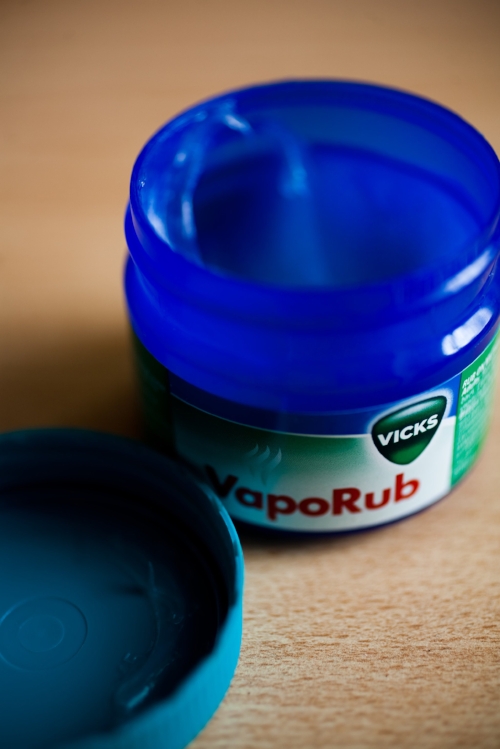The dreaded broken nail. First thing first: It’s important to take proper care to prevent infection and treat the wound. That’s where we come in! We reached out to Dr. Dana Stern, a dermatologist specializing in nail care, to discuss what exactly you should be doing to care for your broken nails. Ahead, Dr. Stern, MD, shares her best tips and tricks for combating broken nails. Plus, we included some of the best YouTube tutorials for the different methods of broken nail care.
Nail Diseases
Discolorations, Cracks or Lines on Nails: What Do They Mean?
White Lines on Nails
White spots, streaks and faint white lines on nails are nothing to worry about. But some white lines can be of concern. Dr. Stern breaks down the different types of lines on your nails that indicate it’s time to see a dermatologist.
- Mee’s Lines: White bands that follow the contour of the lunula (half moon). Arsenic poisoning is the classic cause; however, there are also many other potential medical causes including certain vitamin deficiencies and infections.
- Beau’s Lines: Horizontal depression in the nail plate due to growth arrest of the nail from illness, fever or trauma.
Nail Melanoma

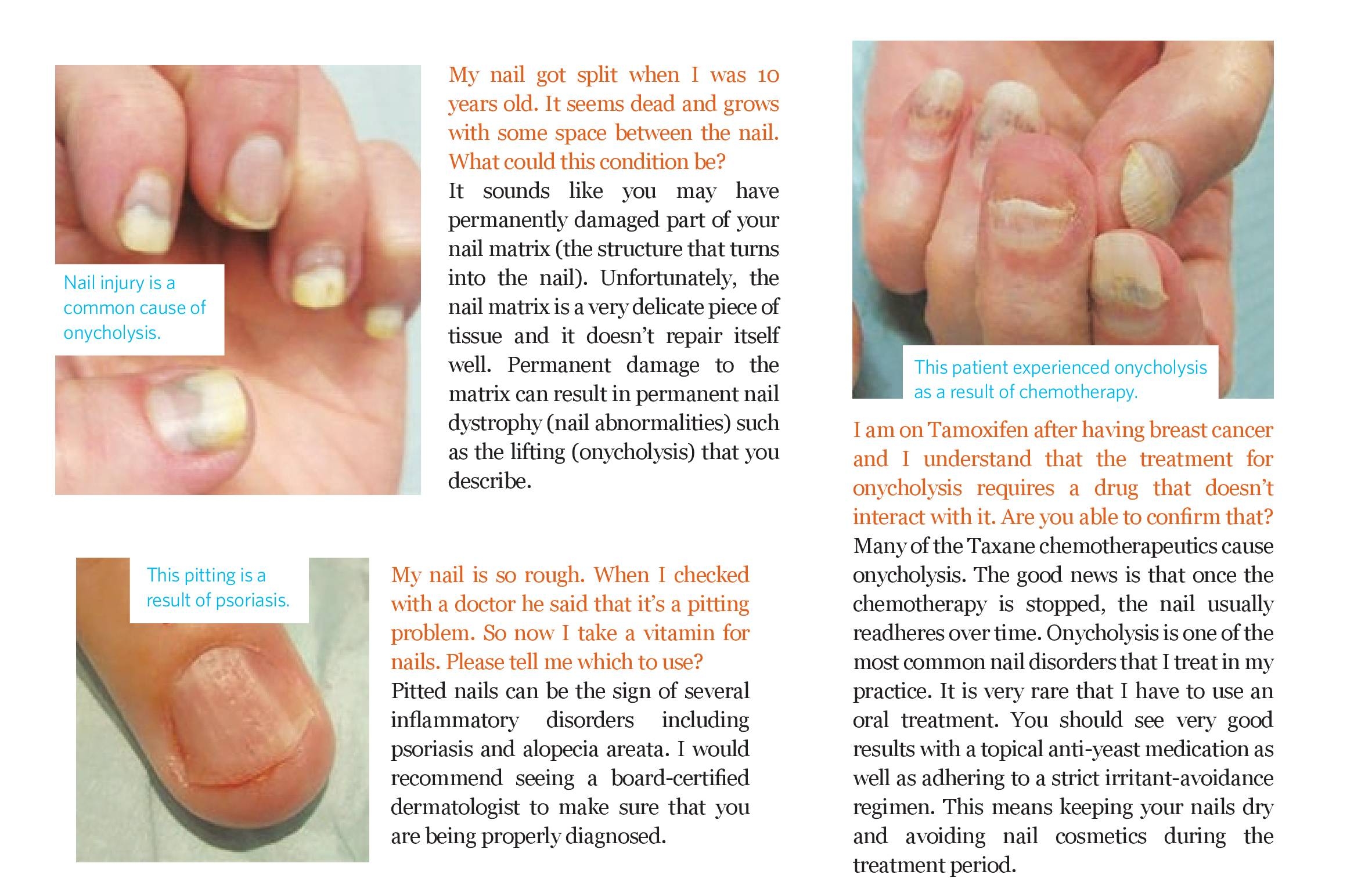
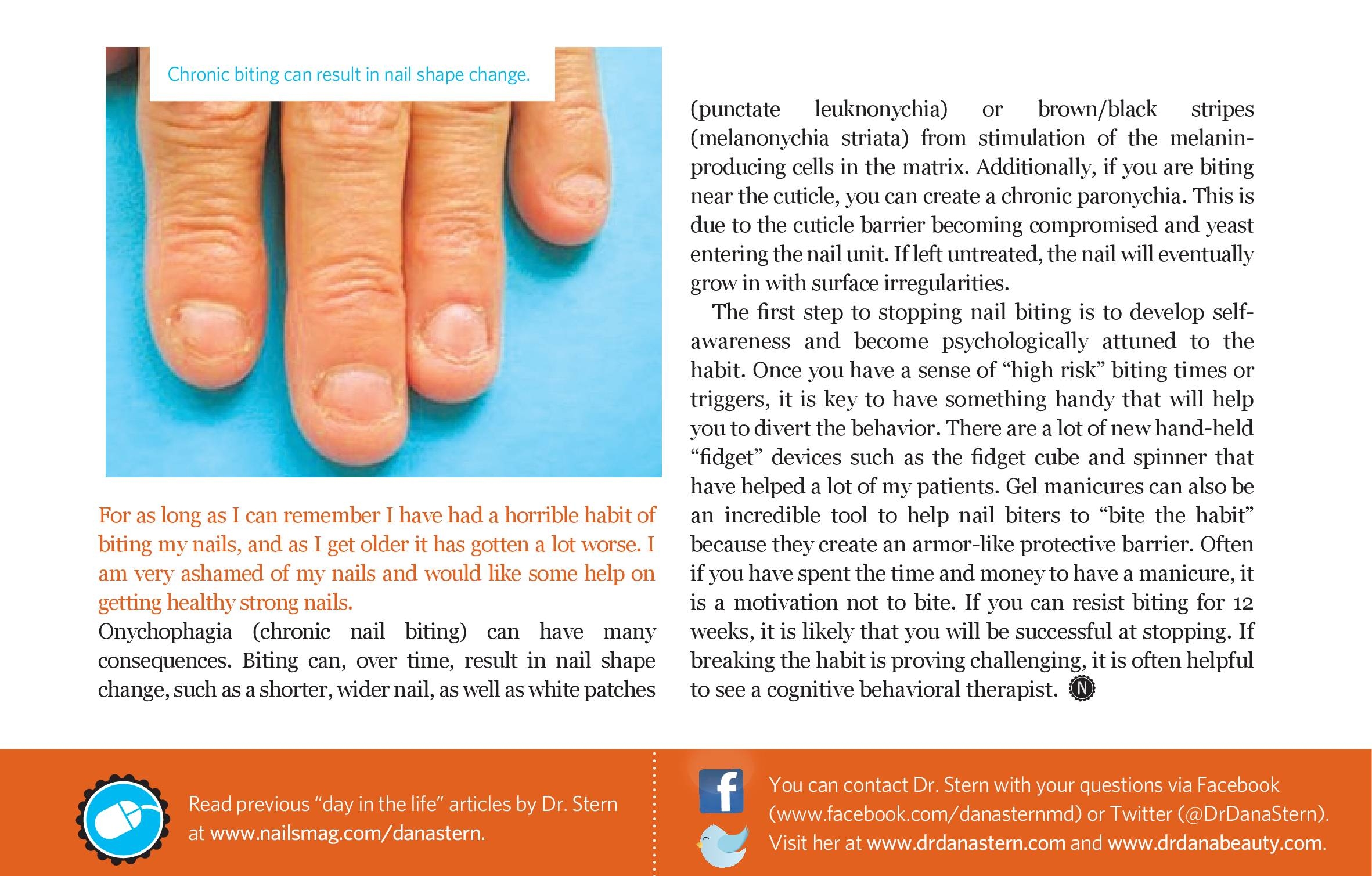
Vicks VapoRub For Toenail Fungus ?
Vicks VapoRub For Toenail Fungus?
A small study published in the Journal of the American Board of Family Medicine tested whether VapoRub had a positive effect on those with toenail fungus. The study, focused on 18 people who used VapoRub on their toenails for 48 weeks, concluded the ointment can help.
Dana Stern, MD, a dermatologist and nail specialist based in New York City, explained why the study (and the overall remedy) should be taken with a grain of salt. "One of the biggest issues with self-treating using home remedies is that the diagnosis is not correct," Stern explained. "Not all yellow, thick, abnormal toenails are fungal; in fact, half are not." She suggests seeing a dermatologist if your VapoRub "treatment is not working after four months for toenails and two months for fingernails."
Nail Ailments From Around The World
Cosmetic Nail Issues
Pseudomonas
Are Your Feet Ready For Sandal Season?
Seeing this phenomenal bronze Einstein sculpture by Robert Berks made me think about sandal season. Interestingly, Einstein had difficulty tying his shoes and so often wore sandals as depicted in this work. Some tips on getting ready for sandal season:
In winter, cold, dry air and over-heated homes result in dry, callused, cracked feet and heels. During the winter months, our feet are hidden in socks, tights and boots and we tend to neglect our foot care because nobody is looking. As a result callus builds, feet are dry and cracked and toenail polish is often left on for way too long creating white surface irregularities at the toenails that are revealed upon removal of polish (keratin granulations). Four easy tips to get your feet sandal ready:
1) First soften superficial dead skin cells and callus either chemically with creams that contain urea (prescription or over-the-counter) or mechanically with abrasives.
Product tips: Over-the-counter Urea containing options include Kneipp Healthy Feet Anti-Callus-Salve, $25, available at DermStore. To mechanically remove the hard, scaly skin with an abrasive, I prefer a foot file with a removable grit such the Flowery Foot File with disposable/removable grit. I am not a fan of pumice stones as they can harbor bacteria and molds once they become wet, due to their porosity. If you are going to use a pumice, use it as a one time use item and dispose of it after each use.
2) Use a rich moisturizer. I am a huge fan of shea as a key moisturizing ingredient and particularly for the feet as it acts as a barrier for the skin and really helps to seal in moisture. I love L’Occitane shea butter foot cream. This particular formula also contains lavender oil making it a calming and relaxing before bed treat for you and your feet. I also like CeraVe Renewing SA Foot Cream for the same reasons that I like other CeraVe moisturizers as it is packed with Ceramides and Hyaluronic Acid, thus mimicking the skin’s natural lipid barrier. The addition of Salicylic Acid will help to prevent callus from returning.
3) If your feet are not just dry and flaky but also red and itchy, you may have tinea pedis (athlete’s foot) and you should see a dermatologist. Toenail fungus often begins on the skin and it is imperative to treat it before it gets to the nails.
4)As for keratin granulations, those pesky white patches that appear on toenails often after prolonged polish exposure – The Dr. DANA™ Nail Renewal System will instantly remove these surface irregularities and discoloration leaving you with lustrous, shiny healthy toenails that are ready for a chic new pair of sandals this spring! Launching March 25th on QVC!
Winter Hand Maintenance Tips
As the weather starts to cool down, I start to see common problem among my patients – dry, cracked hands that are often sensitive and painful! This is because in winter, the outside humidity and temperature drops and indoor air becomes a lot drier. Most people are also washing their hands more frequently or using alcohol based hand sanitizers as flu and cold prevention. As a result, the skin on the hands become dehydrated and parched. Lines around your cuticles and knuckles can also be the result of dryness.
The key to beating dry skin is remembering to moisturize often. Products that contain emollients and humectants are best. I am a huge fan of moisturizers that contain shea as it acts as a barrier for the skin and really helps to seal in moisture. I also like to look for products with glycerin and rich hydrating oils such as Coconut Oil to help with hydration. If your hands are already severely chapped, I suggest using a hydrating overnight treatment with hand gloves. I recommend carrying a cuticle pen for dry for cracked cuticles like Essie’s The Cuticle Pen or a hand moisturizer like L’Occitane’s Shea Butter Hand Cream.
Finally, try to stay as hydrated as possible throughout the winter. We often forget to drink water when we are cold. Hot water with lemon works too!
Everything You Ever Needed to Know About Brittle Nails But Were Afraid To Ask
Nails are composed of small cells made up of a protein called keratin. If you were to look at a nail under a microscope the cells look like roof shingles. These cells are very delicate and extremely absorbent, about ten times more so than skin. This is the reason your nails have much more flexibility after soaking in water.
Can I prevent brittle nails?
It depends. If you develop brittle nails out of the blue, it is potentially a sign of a health issue such as anemia, or a thyroid condition. Therefore, if brittle nails are new for you, see your doctor. Those suffering from an eating disorder or undergoing chemotherapy may also experience nail brittleness as a result of a diet low in protein.
If you don’t have any medical conditions that contribute to brittle nails, there are a few reasons that you could be experiencing brittleness:
-Water exposure. Water is constantly being absorbed and then diffused back out by our nails. This continuous process weakens nails because the delicate nail cells are in a constant state of contraction and expansion. This strain causes lifting and breakage.
-Seasonal Weather Changes. In the winter going from a 70 degree indoor environment to a colder environment causes a change in humidity, and consequently a change in the water content of our nails. This has the same effect as chronic water exposure.
-Chemical exposures. Nail polish remover is not your friend. It may help remove that chipped manicure, but the ingredients, strong solvents, especially Acetone, dry out your nails.
What can I do to repair them?
-Avoid alcohol-based sanitizers
-Use cuticle oil consistently
-Take a break from polish, and give your nails 2-3 weeks to repair
-Try a Biotin supplement of 2000 mcg – 3000 mcg daily, sold over-the-counter at your local health food store or pharmacy.
-Consider using a crystal nail file. They are much more delicate, especially for those who are prone to breakage.
The Hands of Time
Never before have there been more ways to turn back the hands of time and reverse signs of aging. In a world where 50 is the new 30, every day there seems to be a new product or procedure to make us look younger. But, the focus tends to be on the face and the neck while the hands, the other most visible unclothed area of the body, has been largely ignored. Women are starting to look unmatched with youthful faces but the hands of a grandmother. This is mainly because most women are not aware that there are as many cosmetic options for the hands as there are for the face. In this day and age where we live in a “hand-held” world, I have devoted my practice to giving hands the attention they deserve.
No different than wrinkles on a sagging face, hands are a tell tale sign of aging. Hands begin to age due to volume loss and from excessive UV damage. As we get older, we begin to see pronounced veins and tendons, brown spots, loss of elasticity, wrinkles and a peau d’orange texture. Many women are self-conscious by the unsightly appearance of their hands but are unaware that there is anything they can do to change it.
As one of the countries only nail specialists, I am also proud to offer my patients a variety of the most cutting-edge cosmetic procedures for the hand. Hand recontouring restores volume and stimulates collagen regrowth to the hand. For this procedure, I inject RADIESSE, an FDA approved volumizing filler, the results of which can last up to a year or longer. In addition, there are several laser options. For the removal of brown spots, I use the NdYag laser. Fraxel, the go-to laser for facial resurfacing, can be used on the hands for a smoother, more even skin texture, to promote collagen regrowth, and to achieve an overall softening of wrinkles. Regular chemical peels can also be very successful in brightening and evening skin tone and pigment.
The end result…. beautiful, youthful hands that women are no longer embarrassed by, but ready to head to the manicurist to put on a bright, glossy polish that is sure to get their hands noticed.
Back To Work
After Labor Day, as we get back to work, we begin to focus on our appearance. Like a great new haircut or a terrific glow from a new skincare regimen, healthy, well-manicured nails are an integral part of a neat, well kept and put together appearance. In an effort to transform back into professional mode many any of us are planning a visit to the nail salon this week. Here are 5 helpful Salon Safety Tips to get your nails healthy, beautiful, and back to work!
1. Cuticle Oil Dropper vs. Brush - Cuticle oil must be dropped as opposed to brushed onto a client’s cuticles. Cuticle oil brushes are not sanitary to use on multiple clients because oils can easily harbor organisms such as bacteria and fungus.
2. Buffing Block – These tools can be miracle workers for buffing out superficial nail alterations or for polishing the nail to a beautiful shine but be careful that your nail technician is using the right grit for your nails! Buffing grits vary like sandpaper grades and many of the buffers out there are meant for acrylics and not natural nails. This is a one-time use item and should be used on only one client and then discarded! Porous buffing blocks can harbor organisms such as bacteria and fungus.
3. Orange Sticks – These harmless looking double sided sticks often have a sharp tip on one end that is used for cleaning under the nail and a blunt tip on the other end used for pushing back at the cuticle. Be careful with cleaning under the nail as a sharp object under the nail can cause the nail to separate from the nail bed. In salons these tools should be one time use only!
4. Hand Washing – This may sound obvious, but you might be surprised! Your nail technician should always wash his or her hands before and after attending to you.
5. Emery Board – This is a one-time use item and should be used on only one client and then discarded! Porous emery boards can harbor organisms such as bacteria and fungus.
A Healthy Nail is a Beautiful Nail
The recent problems highlighted by Mentality Nail Polish reminded me of how important it is to carefully review beauty and personal care product ingredients and to choose reputable companies where health is emphasized in addition to beauty. Recently, users of Mentality Nail Polish reported nail lifting, redness, and burning sensations after they applied the polish. The photos consumers posted appeared to be a condition called onycholysis – when the nail lifts off of and separates from the underlying nail bed.
Reps from the company have blamed the Arminex base used in their polish, claiming some users may have experienced some sensitivity to the product though bloggers have speculated that it was contaminated with other potentially harmful ingredients. The alarming reality is that something as fun and harmless as a nail polish can pose a legitimate health risk. Small batch or indie manufactures often are constrained by budgets and don’t perform the same types of tests that larger companies invest in. The FDA is not obligated to test cosmetic products prior to being released to market. The responsibility to research ingredients and to seek out trustworthy companies falls on the consumer.
I have discussed the health hazards of nail polish before – many nail polishes continue to contain toxic ingredients. I always recommend using a 5-free nail polish (excludes DBP, Toluene, Formaldehyde Camphor and Formaldehyde Resin). DBP is an endocrine disruptor, meaning it is a reproductive toxin that has been related to lifelong male reproductive issues. Toluene can lead to nervous system disorders. Formaldehyde is a suspected carcinogen and while it can help create a harder nail plate, it also lowers flexibility and increases brittleness over time. Furthermore, Formaldehyde can cause nail changes such as bluish discoloration/throbbing pain, infections, and dryness of fingertips. Camphor has a direct effect – it can lead to headaches, dizziness, and nausea, and Formaldehyde Resin is a known allergen and its effects start with the lifting of the nail and can lead to more severe reactions such as burning, itching, irritation, and peeling of the surrounding skin.
As always, I recommend taking your health into your own hands. Choose products from well established reputable companies where health is emphasized. After all a healthy nail is a beautiful nail.
Read More
Sunscreen Decoded
What does SPF means?
SPF, or Sun Protection Factor, indicates how long it will take for UVB rays to redden skin when using a sunscreen, compared to how long skin would take to redden without the product. UVB rays cause sunburn and can contribute to skin cancer, however we now also know that UVA rays also contribute to both photo-aging and skin cancer as well. UVA contributes to and may even initiate the development of skin cancers. Therefore, the SPF is only telling you how much protection you are getting from the UVB rays, and not the damaging UVA rays!
What is broad spectrum protection?
Broad spectrum simply means that it blocks BOTH UVA and UVB rays. Therefore, you MUST always choose a sunscreen that is broad spectrum.
But what SPF level should I use?
While certain oils and lotions with low SPF are labeled as sunscreen, I always recommend using a sunscreen with at least SPF 30. Beyond 30, the protection gained becomes negligible. To give you an idea of how well you are protected, SPF 15 blocks 94% of rays, SPF 30 blocks 97%, SPF 50 blocks 98%, and SPF 100 block 99% of rays. But be careful! Just because you use a sunscreen with a higher SPF does NOT mean you are protected for a greater length of time – you must reapply EVERY 2 HOURS.
Do the ingredients in sunscreen matter?
Yes!!! Broad spectrum sunscreens contain either chemical blockers or physical blockers. Physical blockers such as Titanium Dioxide and Zinc Oxide are more effective and are my ingredients of choice. Make sure that these ingredients are listed in the active ingredients of the sunscreen you choose.
How often should you reapply?
I recommend reapplying sunscreen every 2 hours if you are consistently outside.
Should I use sprays or lotions?
I don’t love sprays simply because I don’t like the idea of inhaling all of those chemicals.
I always sit in the shade so I don’t need sunscreen, right?
This is a common misconception. While sitting in the shade generally protects you from getting a sunburn, sand and water can still reflect UV radiation, so you are still exposed! Similarly, even if it is a cloudy day, UV rays can break through a cloud cover. I am a huge fan of sun protective clothing. As someone who lives at the beach, you will always see me in a rash guard and wide brimmed hat.
I wear sunscreen every time I go outside – what else can I do?
Make sure that you are protecting every part of your body – ears, neck, feet, head, and lips are often neglected. Remember to apply sunscreen at least 15 minutes before exposure, not when you get to the pool. Hats, lip balm, and shoes can all help protect exposed parts that are often forgotten.
It is tick season...
It is tick season in The United States. Whether it is The American Dog Tick (a carrier of Rocky Mountain Spotted Fever and Tularemia), the Blacklegged Tick (most in famous for spreading Lyme, Anaplasmosis, and Babesiosis), the Dog Tick (carrier of Rocky Mountain Spotted Fever), or the easiest of the bunch to identify, the Lone Star Tick (carrier of Ehrlichiosis, Tularemia and STARI), ticks are omnipresent at this time of year no matter where you live. If you live on the East Coast, chances are that you know someone who has recently removed a tick or has been diagnosed with Lyme’s disease. There is so much confusion when it comes to this topic and so back by popular demand, the Dr. Dana Tick Blog. Here are some tips and resources to help you and your family stay safe this summer!
Prevention:
· Check for ticks daily, especially under the arms, in and around the ears, inside the belly button, behind the knees, between the legs and in the buttocks, around the waist, and on the hairline and scalp. Children should be checked every night at bath time as part of your spring/summer routine if you live in a tick endemic area.
· If you have spent time in a wooded or grassy area remove, wash and dry all clothing on high heat and shower as soon as possible.
· Permethrin based insect repellant can be very effective for tick prevention. The product should be sprayed on clothing or shoes and NOT directly on skin. Several brands such as Repel are available on-line.
· Create a “tick-safe” yard by mowing the lawn frequently, keeping leaves raked, and having children play away from tall grasses. Consider having your property sprayed.
· Treat your dogs and cats as recommended by your veterinarian. Do not allow them into your bed or on your furniture, as they are a possible vector for carrying ticks.
How to safely remove an attached tick:
· Fine tipped tweezers are best.
· Place tweezers as close to the skin as possible. Try to grab at the base of the tick (the tick’s head). Pull upward with a slow and steady motion. Do not be alarmed if part of the tick remains embedded, as disease transmission is not possible without the whole tick. Try to remove the remaining segments.
· Wash the area with soap and water.
· Put the tick in a sealed baggie ie. a ziplock™ and label the bag with the date the tick was removed and location. Your dermatologist can have the tick analyzed to identify the type of tick as well as whether that particular tick has the organisms within it that cause disease. This information can be very helpful in guiding therapy.
Important tick facts:
· In general ticks need to be attached for 36-48 hours before they can transmit Lyme disease bacteria.
· If you find a tick that has likely been attached to your skin for less than 72 hours and you are >8 years old, an important study has shown that taking one dose of Doxycycline can dramatically reduce your chance of getting Lyme’s Disease. (87% effective) Call your dermatologist to discuss the best approach for you.
· There are several different types of ticks (Ixodes, Lone Star, Dog Tick etc), and each tick has different stages of growth when they may or may not carry disease. This is why identifying the tick can be very helpful.
· Most humans are infected through bites of immature ticks called nymphs. Nymphs are tiny (less than 2mm) and difficult to see without a magnifier; they feed during spring and summer months.
· Ticks can be carried by deer, rabbits, birds, squirrels, mice, dogs and cats and therefore all of these animals are potential vectors for the spread of tick-born illness.
Please call my office if you would like to come in to have a tick tested or if you have any tick related questions or symptoms.
In The Country, we are located at 325 Meetinghouse Lane, Southampton
631.287.7307
In The City we are located at 905 Fifth Avenue at 72nd Street
212.734.4007
www.drdanastern.com (for direction to the offices)
Tick Resources: Tick Hotline 631.726-TICK; Eastendtickresources.org & Tickencounter.org
Your Manicure, Your Health
The recent article in The New York Times highlighting the nail salon industry in the metropolitan New York City area exposes the economic, social, and health-related hardships of the nail technicians. As a board certified dermatologist and nail specialist, with a nail focused practice on the Upper East Side of Manhattan, I also find the health implications for consumers of a virtually unregulated, fast-growing, $8.54 billion a year industry to be of grave concern.
The prolific growth of the nail salon industry over the last few decades has resulted in the commoditization of manicure and pedicure services. Like all commodity businesses, the low cost provider generally prevails. In New York City, the nail salon capital of the U.S., there is a salon on practically every block and consequently enormous pressure for salon owners to keep costs as low as possible.
Every day in my office I see patients with salon related nail issues ranging from trauma induced lifting of the nail to serious staph infections. There have been reports of hepatitis acquired from improper disinfection of nail equipment. More common is the spread of fungal infections and warts caused by the re-use of ‘one-time use’ disposable items such as emery boards, buffers and toe separators. These are porous tools that cannot be disinfected. Too often, salons are re-using these items to cut costs with little regard for the safety of their customers. Lack of regulation, coupled with an extremely low margin service has resulted in an environment where health, safety and a clinically driven educational emphasis within the salon environment are low priorities.
According to NYC Public Advocate Letitia James’s policy report in September 2014, based on data from the Department of State inspection of New York City salons from 2008 to 2012, the majority of salons — 56 percent — were in violation of health and safety rules. Currently, the City of New York is not responsible for addressing health and safety in salons.
Proper disinfection of salon equipment requires employing best practices and training technicians; an investment of time and money. Pedicure footbaths, for example, should be disinfected for 10 minutes with an EPA-registered hospital disinfectant after every client. In a salon setting, where margins are lean and time is money, it is challenging for technicians to follow proper disinfection protocols.
Continuing education for salon technicians is offered at tradeshows, conferences and online. However, these courses are costly and not a reality for nail technicians who are making significantly less than the minimum wage. Instead, in-salon training is provided by salon owners whose priorities are driven by increasing the bottom line, which can be in conflict with promoting health, safety and educational growth of their employees.
The salon industry in NYC is not necessarily representative of how salons do business nationwide but the current NYC urban salon paradigm poses a significant threat to the nail salon industry as a whole. The existing economics foster a situation where cost saving choices have compromised the health and well being of both the salon worker and the customer, giving rise to a significant public health issue.
Consumers must be able to objectively evaluate salons in order to make informed decisions. Salon workers deserve to work in an environment where their health, safety and well-being are a priority and where they are compensated fairly. Bronx Borough President Ruben Diaz Jr. recently proposed implementing a letter grading system for salons in New York City akin to the system now in place for scoring city restaurants. The grades should reflect adherence to strict health guidelines as well as an evaluation of the health and well being of the salon workers. This system would promote greater transparency and allows the consumer to choose a salon using an informed decision making process. Lower graded salons, that presumably pose a health risk to both the public and salon workers, would inevitably be weeded out and close.
The current salon model is failing both its customers and its workers. A serious change in oversight and accountability is needed. This will benefit the public, salon workers and the salon owners who take seriously the quality of the services they provide.
Dr. Dana's Top 10 Salon Safety Tips
My patients and closest friends are always asking me if I am pro mani-pedi and what nail salon is cleanest? My answer is simple. I believe that everyone should be able to enjoy a relaxing manicure and pedicure, after all when our hands and feet are manicured we feel put-together, in control and ready for anything. As a dermatologist, surgeon, and mother I like to keep my nails short and clean while never compromising on style. However, nail care MUST be done in a healthy and safe way. I like to tell my patients that they need to take their health into their own hands. Why? According to NYC Public Advocate Letitia James’s policy report in September 2014:
• When the Department of State inspected New York’s salons from 2008 to 2012, they found a majority — 56 percent — to be in violation of health and safety rules.
• Customers have been infected with hepatitis and staph infections due to unclean conditions in nail salons.
• There are no regulations governing proper ventilation in salons.
• Nearly 75 percent of nail salons in the U.S. don’t comply with standards for disinfecting nail equipment. This includes reusing nail files and failing to sanitize foot baths. The latter can cause staph infections, hepatitis and bacterial infections.
While most of us want to turn a blind eye to these statistics, it is my job and mission to educate my patients and friends so that you can continue to enjoy salon services but do so in a healthy and ultimately beautiful way. I go to salons and you too can and should enjoy your next mani pedi. With the help of my top ten salon safety tips, you are now armed with information and ready to kick back, relax and be healthy and beautiful.
1. Cuticle oil dropper vs. brush - Cuticle oil must be dropped as opposed to brushed onto a client’s cuticles. Cuticle oil brushes are not sanitary to use on multiple clients because oils can easily harbor organisms such as bacteria and fungus.
2. Emery Board – This is a one time use item and should be used on only one client and then discarded! Porous emery boards can harbor organisms such as bacteria and fungus.
3. Buffing Block – These tools can be miracle workers for buffing out superficial nail alterations or for polishing the nail to a beautiful shine but be careful that your nail technician is using the right grit for your nails! Buffing grits vary like sandpaper grades and many of the buffers out there are meant for acrylics and not natural nails. This is a one time use item and should be used on only one client and then discarded! Porous buffing blocks can harbor organisms such as bacteria and fungus.
4. Orange Sticks – These harmless looking double sided sticks often have a sharp tip on one end that is used for cleaning under the nail and a blunt tip on the other end used for pushing back at the cuticle. Be careful with cleaning under the nail as a sharp object under the nail can cause the nail to separate from the nail bed. In salons these tools should be one time use only!
5. Toe separators – Although great for keeping your toenails from smudging your perfect pedi, these foamy devices can harbor organisms such as bacteria and fungus and should be disposed after use.
6. Whirlpool footbaths – I apologize in advance for this one, you are not going to like what you hear. You should never place your feet in a salon foot spa that has jets. It is impossible to clean in the space behind the jets and these baths are supposed to be disinfected by using a 10-minute bleach bath in between every client. These tubs can therefore put you at risk for acquiring a bacterial or fungal infection. In an extreme case, there was a death reported secondary to a pedicure in the state of Texas when a woman acquired a staph infection from a pedicure footbath. Alternative options do exist. Do not be embarrassed to ask for a plastic basin to soak your feet in. You can also visit salons that only use basins without jets or you can always request a dry pedicure.
7. Hand washing – This may sound obvious, but you might be surprised! Your nail technician should always wash his or her hands before and after attending to you.
8. Ventilation – Have you ever walked into a salon and been overwhelmed by the smell of chemicals in the air? While there may be some of you out there like Jennifer Lawrence's character Rosalyn in American Hustle who love the smell of a really sticky top coat, salons are supposed to have special ventilation systems to ensure the health and safety of both the salon workers and the salon clients. A super, toxic smell is never a good sign!
9. Pumices – We are not huge fans of these volcanic derived stones that are often used as abrasives for removing callus. Although they can work well for callus removal, they are extremely porous, cannot be disinfected and once they become wet they become the perfect place for molds, bacteria and fungus to flourish. Instead use a file with removable grit or a stainless steel file that can be disinfected after each use.
10. The "foot razor" - Used to remove calluses, is illegal in many states and should be! Salon workers are not medically trained to deal with accidental mishaps that can occur with these blades such as cuts or lacerations. Additionally, if these blades are reused they can transfer serious infections between clients. Protect Yourself: Use a callous solution or heel cream at home to safely break down hardened skin. Callus can also be safely removed at the salon with a removable grit file or a stainless steel file that can be disinfected after each use.
Manicare: The Manicure To Show You Care
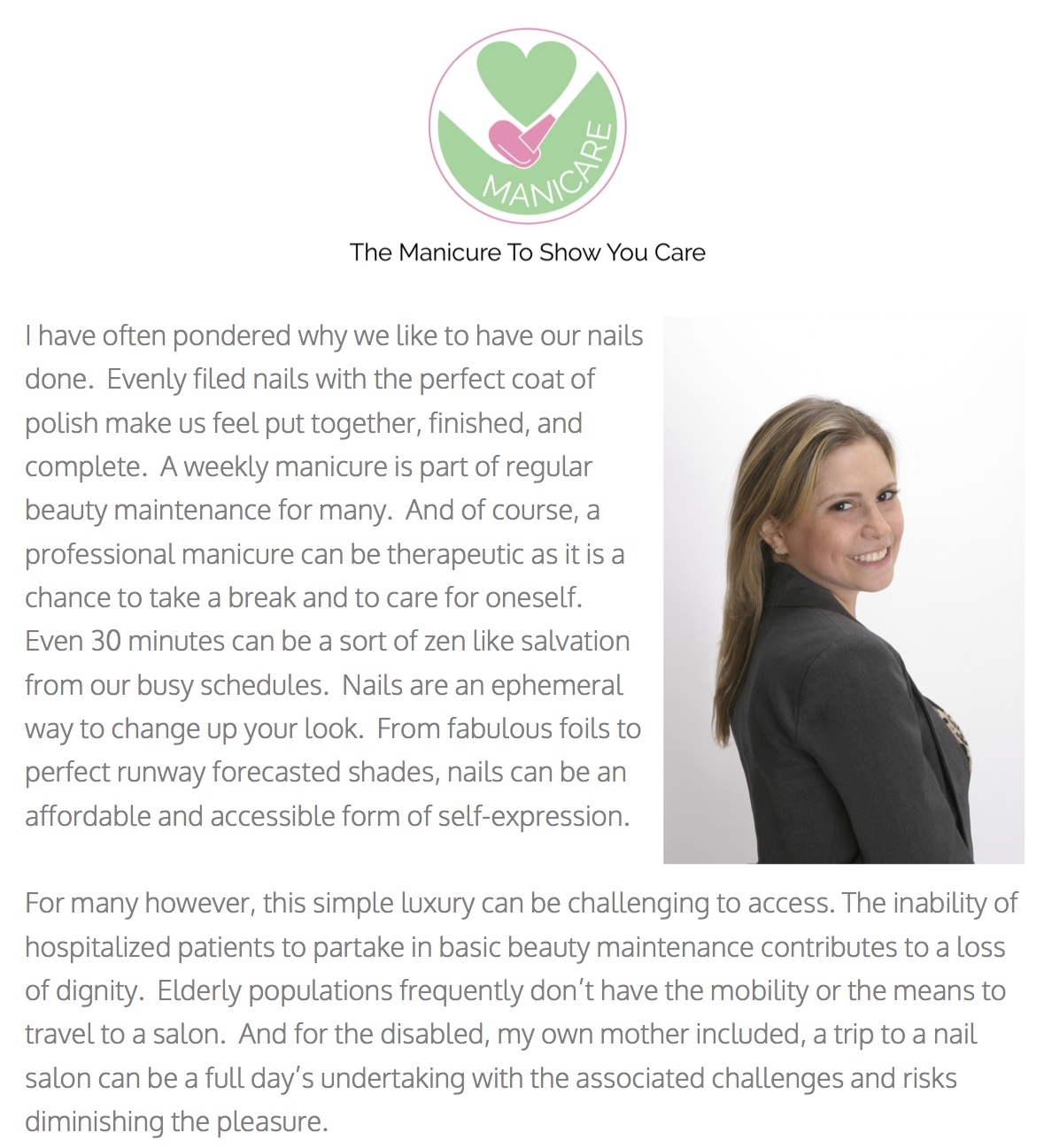
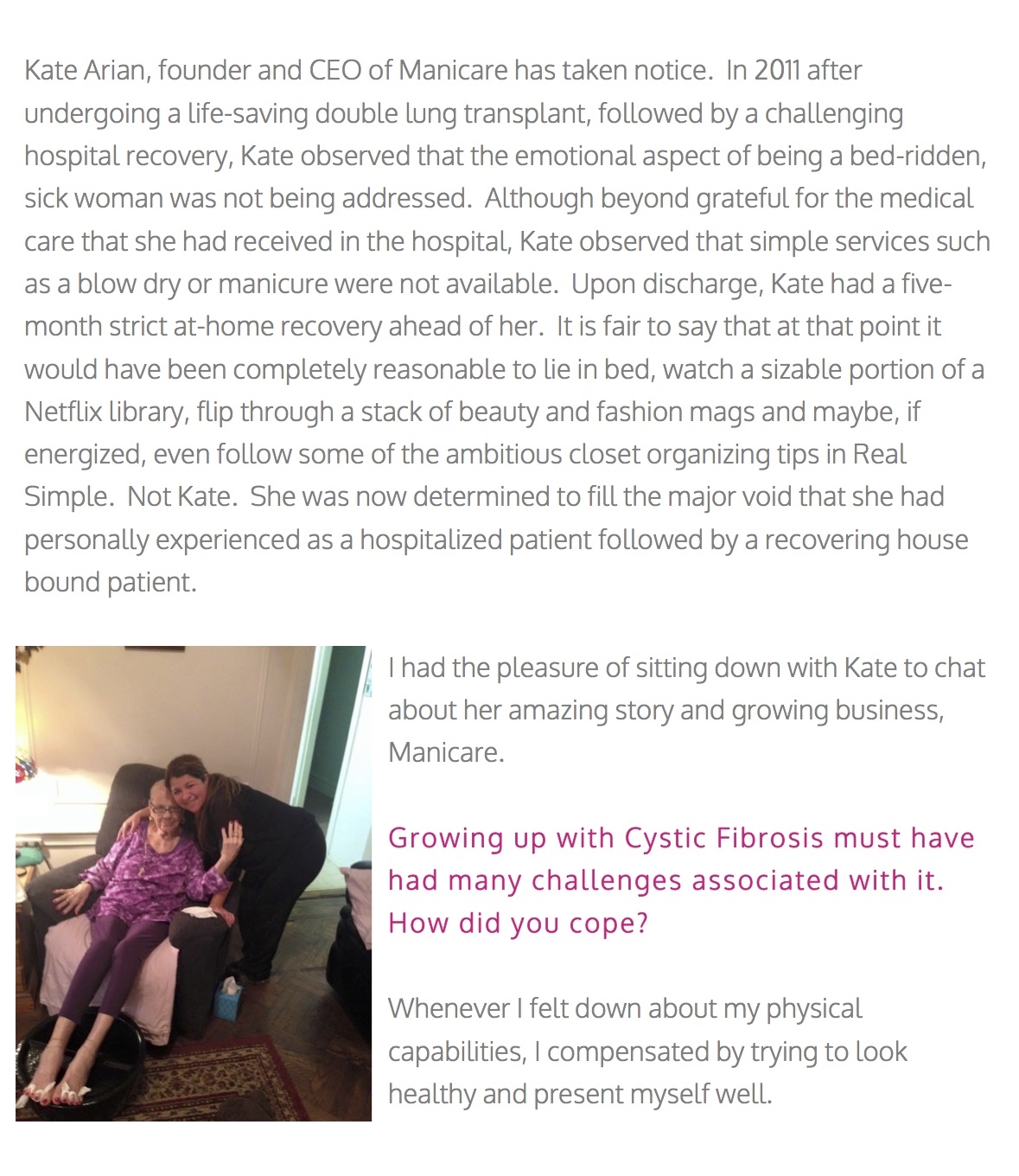
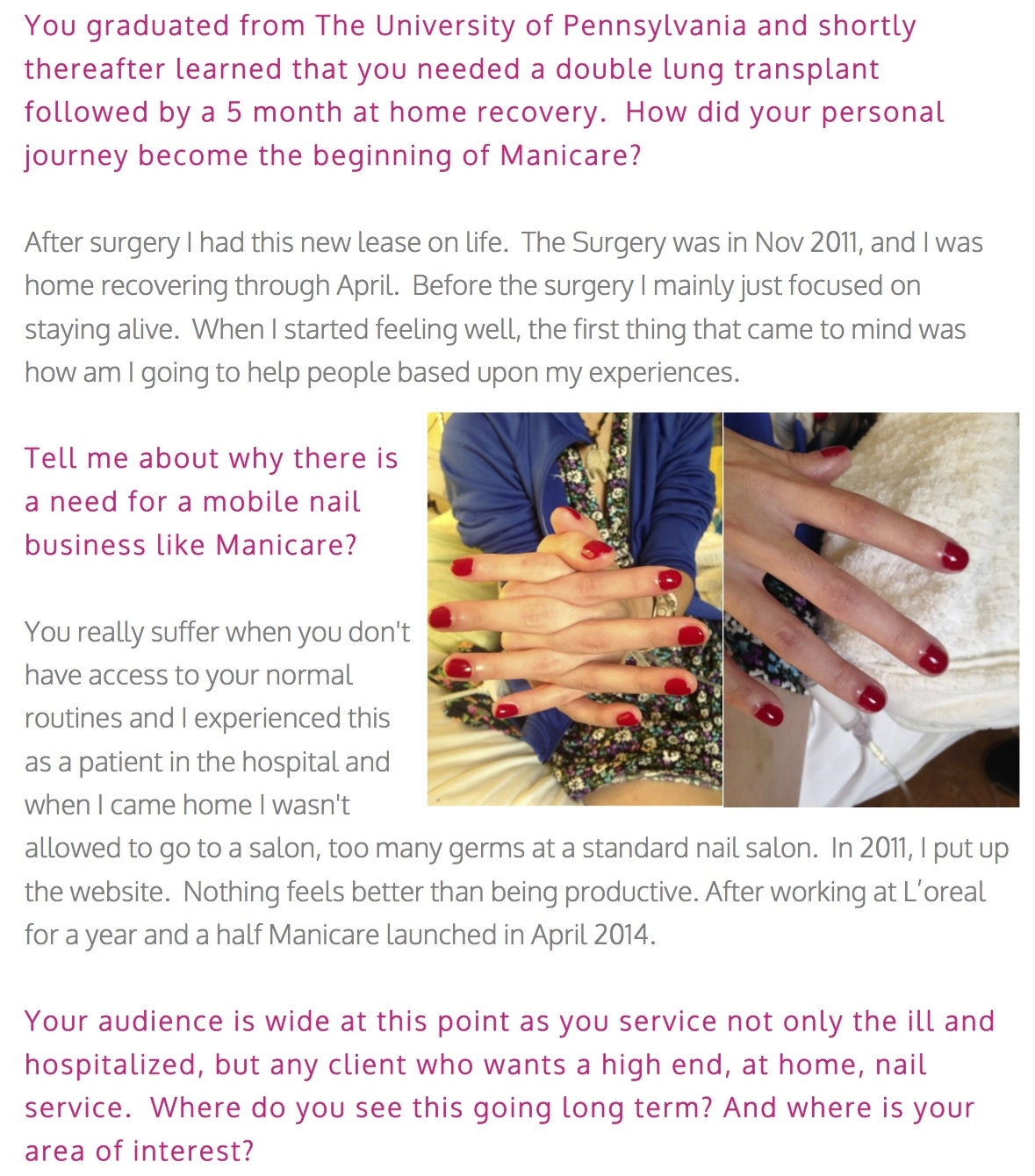

Male Nail Care - Is There Such A Thing?
I am very popular at dinner parties. Inevitably, the typical scenario is several people know or learn that I am a dermatologist and at some point during the evening I am oh so subtlety motioned into a dark corridor or to a far reaching powder room where I am asked to view a suspicious mole on a leg, an odd and persistent rash on someone’s chest, or commonly an abnormal looking toenail. Modesty does not usually come into play during these intimate interactions and very often these bathroom consults veer off into additional personal anecdotes relating to prescriptions, sleep habits and sexual issues.
Recently at a dinner party I was seated at a table with a healthy mix of hedge funders and art world. Prepared for the usual discussions of the art bubble, where everyone is booked at Basel and the latest activist investor controversies, the conversation suddenly turned to me and my area of expertise – nails. It soon became apparent that everyone at the table – (yes, the macho Wall Street guys too) was openly discussing their last pedicure experience.
This was so much more interesting than the usual dinner party chatter and it was so enlightening to learn that men are not only engaging regularly in professional nail care but that they are talking about it openly and unapologetically.
Perhaps it is no surprise, then, that the salon and beauty industry are taking notice. Man cave stylized Hammer & Nails Salon, an all male salon that opened on Melrose Avenue in LA was the brain-child of Michael Elliot who observed that men want to feel groomed but don't necessarily feel comfortable walking into a female dominated and decorated space. Per The New York Times, over half of the men’s treatments in the Essie nail area at the posh Samuel Shriqui Salon on the Upper East Side are finished with polish, usually clear. And while men are currently favoring a naked nail, shiny buff or a simple coat of clear there is a definite new openness towards color. Thanks to social media, celebrity culture has shared and embraced the “man-icure” trend. From Snoop Dog’s nail art on Instagram to Brad Pitt’s rainbow stripe manicure that he recently sported at the Palm Springs International Film Festival, it is clear that nail care is no longer exclusively a female cultural norm.
Nail care is about being kempt and caring about your appearance, hygiene and health. Soft feet and well manicured toenails are appreciated by any partner under the sheets. For those who are still not ready to enter a nail salon, here are some tips that you can do at home to step up your hand and foot game.
1) Invest in the right tools. For a basic manicure and pedicure all that you will need is a new high quality fingernail clipper, toenail clipper, nail file and a cuticle nipper. If you suspect that you may have toenail fungus, you will need two sets of implements and should see a dermatologist.
2) Use the tools properly. After clipping your nails use the file to smooth any sharp edges. The cuticle nipper is only used when you have the occasional hang nail. Hang nails should never be pulled off or bitten as they are a very common site for infections. For general cuticle care simply push them back after a shower with a wash cloth and apply your favorite cuticle cream, balm or oil, especially in cold, dry weather.
3) Remember to clean your tools by rinsing them with antibacterial or dishwasher soap and then soaking them for 5 minutes in either Isopropyl alcohol or Ethyl Alcohol (70%-90%). Swab the tip with alcohol before use.
As I wandered back to join the rest of the dinner party despite the fact that I had disappeared into a dark corridor with a mystery guest my husband had not batted an eye. He knows the drill, he asks me how many consults I have done so far that evening and suggests that I send a bill in the morning…


